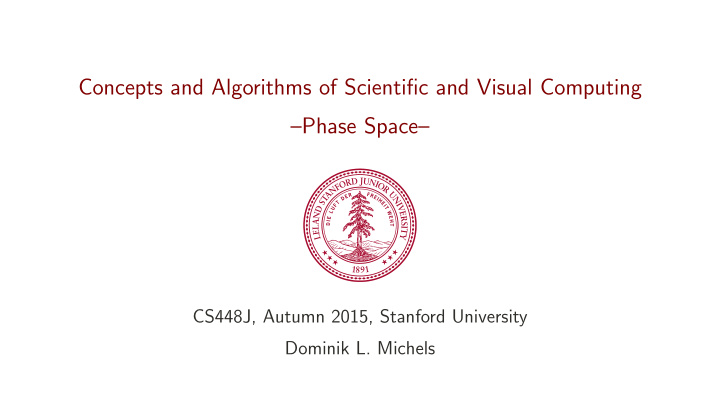



Concepts and Algorithms of Scientific and Visual Computing –Phase Space– CS448J, Autumn 2015, Stanford University Dominik L. Michels
Describing a Dynamical System The position of a particle (i.e. point mass with zero volume) can be described by its location vector x ∈ R 3 given in Cartesian coordinates x 1 , x 2 , x 3 . Its first temporal derivative υ = ˙ x := d t x is called the velocity of the particle and its second temporal derivative x := d 2 a = ¨ t x defines the acceleration.
Describing a Dynamical System For the description of N particles, N location vectors respectively 3 N coordinates are needed. More general, 3 N corresponds to the number of degrees of freedom. It is not always advisable to describe every system in Cartesian coordinates (e.g. polar coordinates for planetary motion): 3 N generalized coordinates q , i.e. arbitrary parameters that uniquely define the configuration of the system relative to a reference configuration. The 3 N temporal derivations of the generalized coordinates are usually denoted as generalized velocities ˙ q .
Describing a Dynamical System Constraints can be expressed implicitly with an appropriate choice of generalized coordinates. The most common constraints are so-called holonomic constraints described by equations of the form f i ( q i ,..., q 3 N ) = 0 for the k constraints i ∈ { 1 ,..., k } reducing the number of degrees of freedom from 3 N to 3 N − k .
Describing a Dynamical System The coordinates alone are by no means sufficient to completely describe the configuration (i.e. the physical state) of a dynamical system. In other words, 3 N − k coordinates are not enough to predict the future state of the systems based on the actual one. To describe the system’s configuration adequately for a given point t in time, the 3 N − k generalized velocities are needed in addition . From a mathematical point of view, this means that for given positions and velocities, the corresponding accelerations are uniquely determined. This relation between the accelerations and the positions and velocities is typically given by a differential equation of motion.
Describing a Dynamical System For the description of the dynamical behavior of a dynamical system, the complete trajectory is required, i.e. a mapping from the time parameter t taken from the considered time interval to the system’s configuration: q ( t )) ∈ R 3 N − k × R 3 N − k . R ⊇ [ t i , t f ] ∋ t �→ ( q ( t ) , ˙ The trajectory describes the solution of the equation of motion.
Phase Space From a geometric perspective, every configuration of a dynamical system corresponds to a point in the space V spanned by the generalized coordinates q and velocities ˙ q . The temporal evolution of the system describes the trajectory represented by a curve in V . As we will see later, instead of considering V , it is natural to make use of the so-called phase space U which is spanned by the generalized coordinates q and momenta p . Similar to V , the phase space U provides a modern entry to mechanics and their underlying geometric nature.
Illustration: Simple Pendulum φ φ φ Figure : Phase space of a pendulum with one degree of freedom, uniform mass and rod length.
Recommend
More recommend